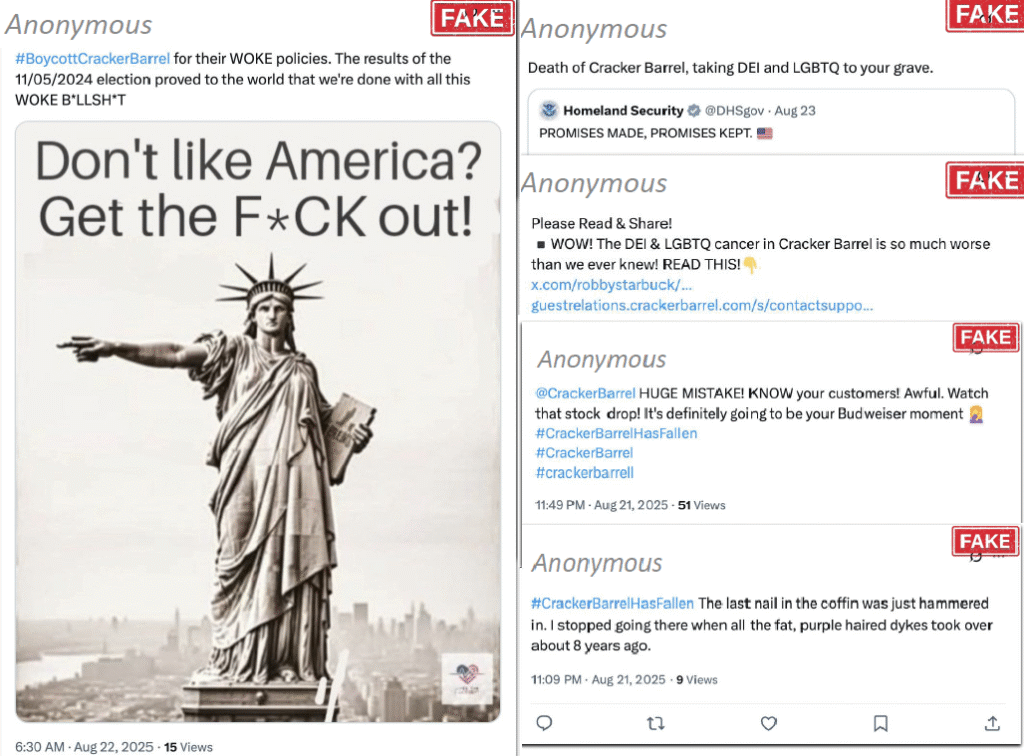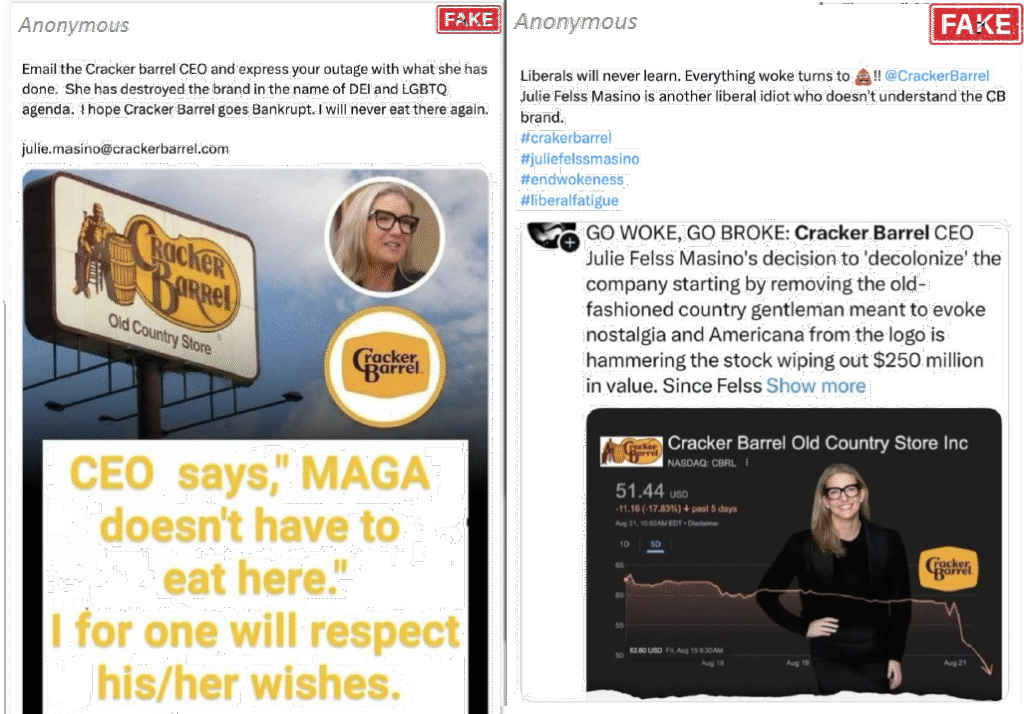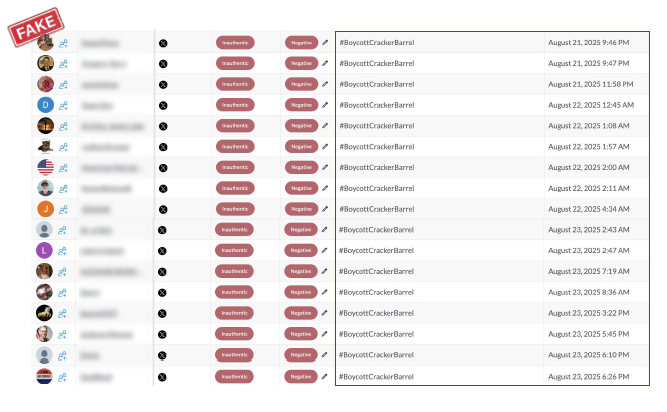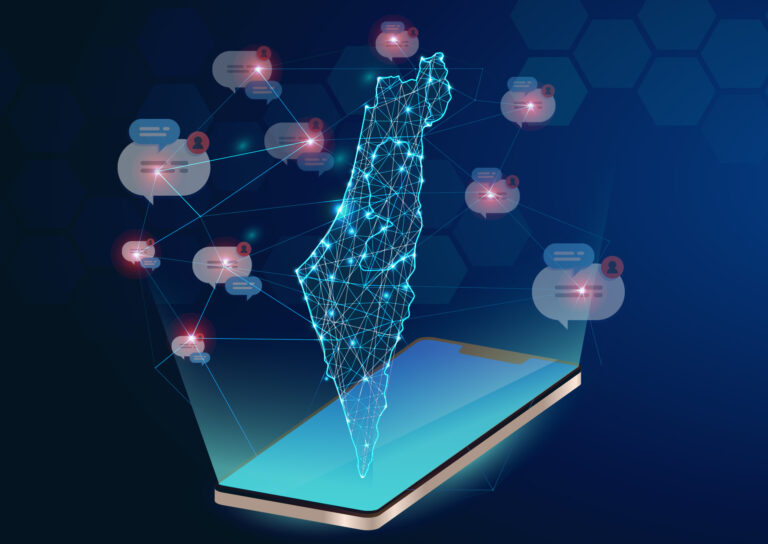American restaurant and gift shop chain Cracker Barrel faced intense backlash following its logo redesign, which removed the traditional figure of a man leaning against a barrel. A week later, after a sharp 10.5% drop in Cracker Barrel’s stock price, the company announced that the logo would be reverted back following the heavy criticism.
However, Cyabra’s research uncovered that Cracker Barrel’s branding crisis was significantly amplified by a coordinated network of fake profiles, which has a massive impact on online conversations surrounding the company.
TL;DR
- Cyabra identified 21% of profiles discussing Cracker Barrel’s logo change as fake accounts orchestrating a coordinated disinformation campaign
- These fake profiles’ content reached over 4.4 million potential views and thousands of authentic profiles’ engagements
- The manufactured outrage correlated with a 10.5% stock price drop ($100M in market value) that occured within days of the announcement
A Crisis Manufactured by Bots
Cyabra’s investigation revealed a sophisticated disinformation campaign targeting the restaurant chain across social media platforms, particularly X. By analyzing thousands of profiles engaging in the conversation, Cyabra mapped inauthentic behavior patterns and exposed coordinated strategies. The data showed a substantial portion of the negative discourse was manufactured by fake accounts working to amplify hostility, promote boycott narratives, and undermine public trust.
The Numbers: Quantifying Manufactured Outrage
The scale and impact of this coordinated attack is striking:
- 21% of profiles were fake: more than one-fifth of the profiles in the conversation were identified as inauthentic accounts, and were actively attacking Cracker Barrel using the hashtags #BoycottCrackerBarrel, #CrackerBarrelHasFallen, #CrackerBarrelCEO, and #CrackerBarrelIsFinished.
- 4,452,000 potential views: fake profiles created hundreds of posts and comments specifically crafted to damage Cracker Barrel’s reputation, and the manufactured campaign exposed millions of authentic profiles to coordinated negative messaging and disinformation. These fake profiles also triggered 3,268 direct engagements from genuine profiles.
- 10.5% stock price decline: Between August 20-22, 2025, Cracker Barrel’s stock dropped sharply, coinciding exactly with peak fake profile activity, which represented approximately $100 million in lost market value.
Cyabra’s analysis shows a direct correlation between the surge in fake profile activity and the stock’s decline, with the most intense period of negative posting occurring precisely when the stock experienced its steepest drop.

Strategic Narrative Manipulation
Cyabra’s investigation uncovered three distinct strategic narratives consistently pushed by fake profiles:
1. “Betrayal of Tradition” Framing
Fake profiles portrayed Cracker Barrel’s rebranding as a rejection of its core audience and an embrace of “woke” politics. These accounts claimed the company was “erasing nostalgia and heritage” by removing the iconic barrel figure. Messages consistently accused the company of surrendering to a “woke agenda” instead of preserving traditional American heritage. Many fake accounts specifically compared the situation to Bud Light’s controversial 2023 campaign.

2. Boycott Campaigns and Financial Doom
Fake profiles pushed hashtags like #BoycottCrackerBarrel and #CrackerBarrelHasFallen, creating the impression of a massive consumer revolt. These accounts made exaggerated claims about imminent financial collapse, often stating the stock price would “crash” and restaurants would soon close nationwide. They promoted deleting the Cracker Barrel app and announced they would never set foot in any of the chain’s stores again, or purchase any of its products. By portraying the boycott as already successful, these profiles created a self-fulfilling prophecy of declining consumer confidence.

3. CEO Julie Masino’s “Failed Leadership”
Fake accounts targeted Cracker Barrel’s CEO Julie Felss Masino personally, framing her as “destroying the brand”, accusing her of being a “progressive leftist” and out of touch with American culture and Cracker Barrel’s traditional southern audience and heritage, questioning her competence, and using her as a scapegoat for all perceived company issues – stock decline, logo change, or DEI initiatives. These personalized attacks simplified complex corporate decisions into a narrative of individual failure, creating a clear villain in the public imagination.

From Digital Attacks to Financial Damage
Cracker Barrel’s 10.5% stock price drop represents approximately $100 million in lost market value – concrete evidence of how digital manipulation translates to financial damage.
This fake campaign succeeded by:
- Creating an illusion of consumer rejection: Flooding platforms with negative content manufactured the appearance of widespread customer abandonment.
- Framing a routine change as catastrophic: What might have been viewed as a standard brand refresh was positioned as a devastating mistake through coordinated messaging.
- Generating mainstream media coverage: The manufactured outrage attracted attention from most major news outlets, further amplifying its reach.
- Establishing persistent negative narratives: Strategic hashtag deployment ensured negative framing dominated search results and social conversations about the brand.
And of course, at the end, Cracker Barrel’s decision to revert the logo back to its original design was seen as “caving”, making this fake campaign successful in its goal.
Warning Signs for Communications Teams
For PR professionals, this case reveals critical warning signs of coordinated inauthentic activity:
- Sudden surges in negative comments from accounts with limited history
- Identical talking points appearing across multiple posts in short timeframes
- Rapid emergence of specific boycott hashtags quickly dominating the conversation
- Excessive criticism targeting individual executives rather than specific actions
- Disproportionate engagement compared to typical brand conversations
Cracker Barrel was particularly vulnerable due to:
- Visual identity changes that could be framed as “abandoning tradition”
- Brand identity closely tied to traditional values and customer nostalgia
- Timing coinciding with broader cultural debates about corporate diversity initiatives

Protecting Against Inauthentic Brand Attacks
Cyabra’s analysis suggests several essential protective measures:
Detection and Monitoring
- Implement social listening tools that distinguish between authentic and inauthentic engagement
- Monitor sudden spikes in specific hashtags, especially boycott messaging
- Analyze network connections between accounts pushing similar narratives
- Track sentiment patterns to identify coordinated shifts in messaging
Response Strategies
- Assess authenticity before responding to criticism waves
- Distinguish between genuine customer concerns and manufactured outrage
- Consider transparency about identified fake activity rather than engaging with manipulated narratives
- Prepare stakeholders for potential volatility during high-profile brand changes
Building Resilience
- Establish baseline metrics for normal engagement patterns
- Educate leadership about potential inauthentic amplification
- Develop rapid response protocols for coordinated inauthentic behavior
- Consider partnerships with authenticity detection services
The Cracker Barrel case demonstrates why distinguishing between genuine concerns and coordinated attacks is essential for protecting brand reputation and market value.


